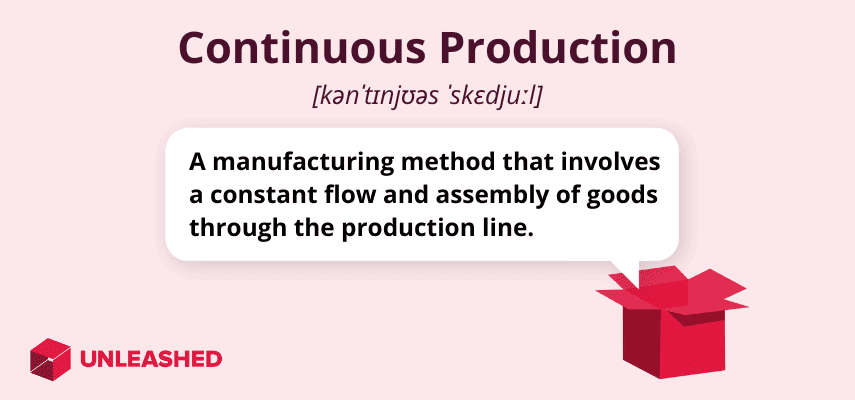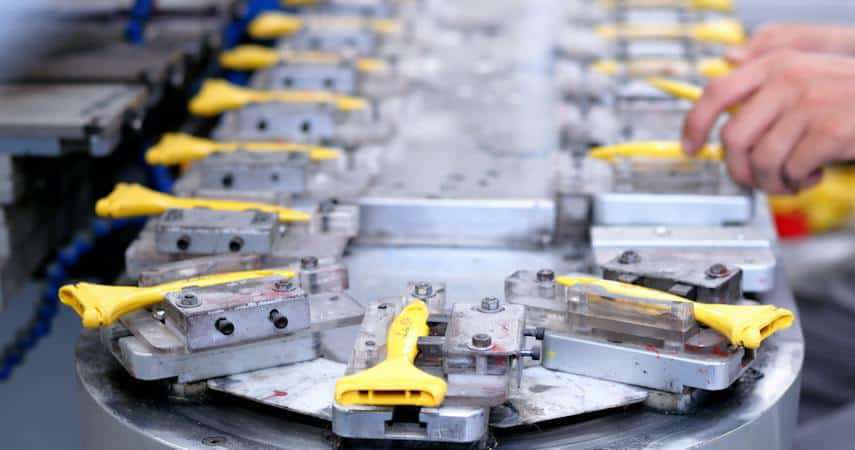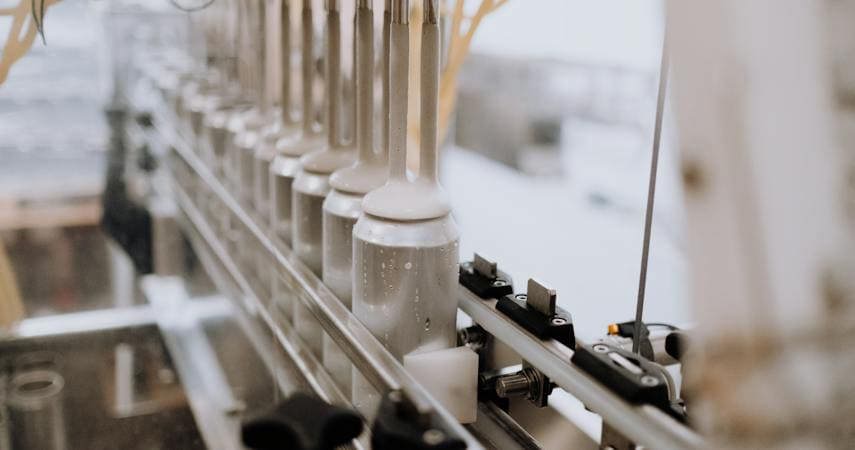
Continuous production is a manufacturing method that involves an uninterrupted flow in the manufacturing line and a consistent delivery of goods. It’s a strategy best suited for manufacturing businesses seeking an efficient way to produce a large volume of products.
This article breaks down the meaning, pros, and cons of continuous production, and explores some best practice examples for implementing a continuous production workflow.
What is continuous production?
Continuous production is a manufacturing method that involves the continuous production of goods for sale. It aims to create non-stop operations of goods that are the same or similar. Continuous production is a highly automated process that creates large numbers of products more quickly and efficiently than other common manufacturing practices.

Features of a continuous production workflow
No two continuous production systems are alike. However, there are defining characteristics that help us define this production method. Standard features of a continuous production workflow include:
- Uninterrupted production processes – Production runs 24/7 with minimal need for human intervention.
- Streamlined processes – Your workflows are largely automated and linked to software that staff can manage.
- No variance – Ideal for bulk production of the same or similar products as it does not lend itself to variations.
- High volume output – Designed for producing large quantities of goods with a consistent demand in an efficient way.
- Consistent quality – It maintains a high level of consistency in product quality as goods are always produced the same way.
Batch production vs continuous production: What’s the difference?
Batch production and continuous production are both manufacturing methods for producing large volumes of goods at once. However, they’re not the same thing.
Batch production refers to goods being produced in large quantities – called batches or lots – at once, whereas continuous production refers to a constant flow of goods being produced.
In batch production, lots or batches of productions pass right through the production line before another batch begins the process. There is often downtime between each production while the next batch is set up. The production line may also need to be adjusted for the next batch.
Batch production also allows for variances in the products produced. The production machinery and software can be adjusted between batches to allow for different product types to be produced.
In continuous production, products are produced non-stop. There is minimal downtime, and the aim is to create a streamlined operation that doesn't require adjustments or human intervention. Unlike batch production, continuous production doesn’t allow for variances in products. The continuous flow of the production line means there is no ability to adjust settings or outputs.
Continuous production: Advantages and disadvantages
Continuous production can help achieve greater efficiency and quality in your manufacturing process, but it comes with a few downsides. Let’s look at the pros and cons of continuous production.
Advantages of continuous production:
- It enables businesses to achieve greater production efficiency by maximising the output of specific processes.
- Continuous production usually results in a more consistent quality of goods produced.
- It reduces your total production costs by taking advantage of economies of scale.
- You’ll lower your labour costs by automating and accelerating many common processes.
- It allows manufacturers to achieve longer production runs.
- It streamlines the flow of materials through production and minimises human input.
Disadvantages of continuous production:
- It’s inflexible and therefore unsuitable for bespoke manufacturing requirements.
- It can be highly resource intensive as it requires machines to always be running.
- Continuous production usually requires a large initial investment to implement.
- The method assumes the market will stay the same and demand will continue uninterrupted, which can create market risk.
- It requires specialised equipment that may be challenging to procure, learn, or install.

Continuous production examples
The continuous production method is typically used in industries that produce a high quantity of products of the same quality to be delivered at a constant, steady speed.
Often, manufacturing industries will implement a combination of production methods to ensure the most effective use of resources and costs. However, some industries lean more heavily on continuous production than others.
Examples of manufacturing sectors that use continuous production methods:
- Steel production
- Paper milling
- Food processing
- Car manufacturing
- Pharmaceuticals
- Electronics manufacturing
Now let’s look at a few famous instances of the continuous production method being deployed.
Heinz
Heinz has long used continuous production for its manufacturing of condiments, sauces, and other food products. Heinz is a huge global company that was founded in America back in 1869. It has moved with the times and leans heavily on automated systems to mass produce its products.
Novartis
According to Novartis, continuous production methods have the potential to cut drug manufacturing time by 90%. They say it also has the potential to reduce drug manufacturing costs by up to 50%. The pharmaceutical giant opened its first continuous-flow manufacturing facility in Switzerland in 2017.
ArcelorMittal
ArcelorMittal uses continuous production for its steel production. The production line drives liquid steel through a mould before it is cooled. It emerges as a solid slab of steel which is then cut to length to be a finished product.
Coca-Cola
A behemoth of the drinks industry, Coca-Cola uses continuous production processes to efficiently manufacture the billions of drinks it outputs each month. Founded in 1886, it started with the Coca-Cola drink but has since expanded into a variety of drinks, including teas, juices, and water. Now, two billion of its drinks are drunk every day, around the world.
ExxonMobil
ExxonMobil uses its advanced processing techniques for its refining, gas, and chemical production. According to ExxonMobil, these processes are best practices and deliver superior results for customers. ExxonMobil is one of the largest chemical companies in the world.
Ben & Jerry’s
Ben & Jerry’s ice cream uses both batch and continuous production methods for its ice cream manufacturing. The company, founded in Vermont, offers tours of its first factory, which was built in 1985 and now manufactures around 350,000 pints of ice cream a day.
Understanding the continuous production process
The essential elements of the continuous production process include:
- Continuous flow: There is a continuous, uninterrupted flow on the production line and with the outputs.
- Steady state: The process is characterised by having a steady state of existence – for example, a consistent temperature or speed of operations.
- Automation: Continuous production lines are generally reliant on automated elements such as robots, conveyor belts, and other types of machinery.
- Control systems: Continuous production processes are often managed through highly technical control systems and tools. These tools control aspects such as speed, temperature, and flow to ensure the production line processes are optimised.
- Integration: Continuous production line processes should integrate with other aspects of the business to ensure a streamlined workflow.
- Energy efficiency: Continuous production lines can be resource-intensive, but the ceaseless state of operations – as opposed to stopping and starting or slowing and speeding up – means it can minimise energy usage.
- Quality control: A high emphasis on quality control is an important part of the continuous production process.

What is a continuous production system?
A continuous production system is a process in which items flow consistently, and in a steady state, through the manufacturing process. It is sometimes also called a flow production system. This method typically requires higher levels of initial investment, as the machinery required can be extremely expensive.
Continuous production systems are highly automated and utilise machinery, robots, and conveyor belts to ensure effective use of the process and produce large numbers of the same product. There is little human intervention in the process.
Generally, continuous production systems are useful for industries that require mass production of a certain product or step in a manufacturing process.
Continuous production is most commonly implemented in industries such as chemical manufacturing, steel and paper production, oil and gas refining, car manufacturing, pharmaceuticals, and some food processing.
Often, continuous production is used alongside other types of production such as batch or job production, combining the different types to ensure the most efficient and cost-effective outcomes.
More posts like this:
